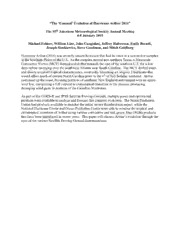
NASA Technical Reports Server (NTRS) 20150002879: The Unusual Evolution of Hurricane Arthur 2014 PDF
Preview NASA Technical Reports Server (NTRS) 20150002879: The Unusual Evolution of Hurricane Arthur 2014
“The ‘Unusual’ Evolution of Hurricane Arthur 2014” The 95th American Meteorological Society Annual Meeting 4-8 January 2015 Michael Folmer, William Line, John Cangialosi, Jeffrey Halverson, Emily Berndt, Joseph Sienkiewicz, Steve Goodman, and Mitch Goldberg Hurricane Arthur (2014) was an early season hurricane that had its roots in a convective complex in the Southern Plains of the U.S. As the complex moved into northern Texas, a Mesoscale Convective Vortex (MCV) formed and drifted towards the east of the southern U.S. for a few days before emerging over the southwest Atlantic near South Carolina. The MCV drifted south and slowly acquired tropical characteristics, eventually becoming a Category 2 hurricane that would affect much of eastern North Carolina prior to the 4th of July holiday weekend. Arthur continued up the coast, brushing portions of southeast New England and merged with an upper- level low, completing a full tropical to extratropical-transition in the process, producing damaging wind gusts in portions of the Canadian Maritimes. As part of the GOES-R and JPSS Satellite Proving Grounds, multiple proxy and operational products were available to analyze and forecast this complex evolution. The Storm Prediction Center had products available to monitor the initial severe thunderstorm aspect, while the National Hurricane Center and Ocean Prediction Center were able to monitor the tropical and extratropical transition of Arthur using various convective and red, green, blue (RGB) products that have been introduced in recent years. This paper will discuss Arthur’s evolution through the eyes of the various Satellite Proving Ground demonstrations.
